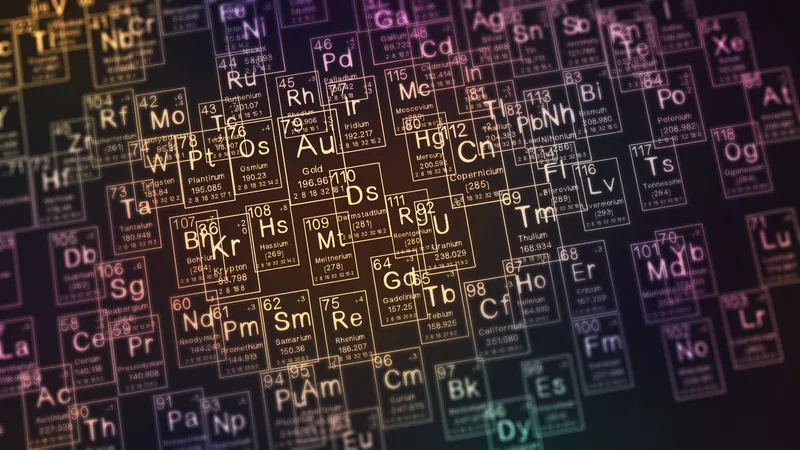
Scientists May Be On the Brink of Unveiling Element 120 – A Game-Changer for the Periodic Table!
2024-11-07
Author: Sophie
Introduction
Researchers are excited as they inch closer to creating a new superheavy element, tentatively named "element 120," which could lead to the addition of a groundbreaking new row in the periodic table. If successfully synthesized, this hypothetical element promises to embody an "island of stability," revolutionizing our understanding of heavy-element chemistry.
The Current State of the Periodic Table
Currently, the periodic table boasts 118 recognized elements, ranging from the lightest hydrogen — with just a single proton — to oganesson, a colossal atom with at least 194 subatomic particles (118 protons and a minimum of 176 neutrons) that was named in 2016. However, scientists hypothesize that even heavier elements exist in the universe. To uncover these elusive elements, researchers face the challenge of either inventing methods for synthesizing them on Earth or searching beyond our planet.
Potential New Elements
The heavyweights in the running for new elements include element 119, also known as ununennium, and element 120, referred to as unbinilium. Due to their monumental mass, these elements don’t fit into the existing seven rows of the periodic table, indicating that a new eighth row would be necessary for their classification upon successful creation. So far, attempts to synthesize either element have not been successful.
Recent Research Findings
A recent study published in *Physical Review Letters* on October 21 detailed an innovative technique for synthesizing livermorium (element 116) through the method of bombarding plutonium-244 (an isotope of plutonium) with vaporized titanium ions. The researchers believe that this same method may be applicable for synthesizing unbinilium by launching titanium ions at heavier isotopes of californium.
Expert Insights
Jacklyn Gates, the study's lead author and a nuclear scientist at Lawrence Berkeley National Laboratory, expressed excitement over this "proof of concept." Gates explained, “This reaction had never been demonstrated before, and proving it was necessary to move forward with our attempts to create element 120. New element production is an incredibly rare occurrence, making this an exhilarating endeavor with a promising path ahead.”
Challenges Ahead
However, patience is crucial for the team, as the process to produce unbinilium could be significantly more time-consuming. The creation of two atoms of livermorium required over 22 days within the strenuous environment of Berkeley Lab's 88-Inch Cyclotron, consistently shot with titanium ions targeting the plutonium isotope. The researchers anticipate that producing unbinilium may take approximately ten times longer than that of livermorium.
The Prospect of Stability
Researcher Reiner Kruecken concluded, “It's not an easy task, but it now seems feasible." Superheavy elements like unbinilium typically decay rapidly after formation, due to their unstable nature. Yet, scientists speculate that once elements achieve a certain mass threshold, they may enter this predicted "island of stability," remaining intact far longer than other known heavy isotopes.
Conclusion
The implication of creating unbinilium is substantial, as it could unlock new avenues for research into superheavy elements. However, there's an air of caution. “Venturing into the synthesis of these rare elements, we are treading the very frontiers of human knowledge, and we must acknowledge that nature might not behave as we anticipate," said Jennifer Pore, another co-author and nuclear scientist at Berkeley Lab.
Final Thoughts
With this cutting-edge research, the scientific world is watching closely — and if successful, the new eighth row of the periodic table could hold secrets that redefine chemistry, physics, and the very foundation of material science! Stay tuned as this exciting story continues to develop!









 Brasil (PT)
Brasil (PT)
 Canada (EN)
Canada (EN)
 Chile (ES)
Chile (ES)
 Česko (CS)
Česko (CS)
 대한민국 (KO)
대한민국 (KO)
 España (ES)
España (ES)
 France (FR)
France (FR)
 Hong Kong (EN)
Hong Kong (EN)
 Italia (IT)
Italia (IT)
 日本 (JA)
日本 (JA)
 Magyarország (HU)
Magyarország (HU)
 Norge (NO)
Norge (NO)
 Polska (PL)
Polska (PL)
 Schweiz (DE)
Schweiz (DE)
 Singapore (EN)
Singapore (EN)
 Sverige (SV)
Sverige (SV)
 Suomi (FI)
Suomi (FI)
 Türkiye (TR)
Türkiye (TR)
 الإمارات العربية المتحدة (AR)
الإمارات العربية المتحدة (AR)